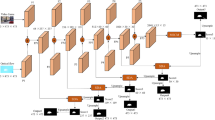Abstract
Current mainstream unsupervised video object segmentation (UVOS) approaches typically incorporate optical flow as motion information to locate the primary objects in coherent video frames. However, they fuse appearance and motion information without evaluating the quality of the optical flow. When poor-quality optical flow is used for the interaction with the appearance information, it introduces significant noise and leads to a decline in overall performance. To alleviate this issue, we first employ a quality evaluation module (QEM) to evaluate the optical flow. Then, we select high-quality optical flow as motion cues to fuse with the appearance information, which can prevent poor-quality optical flow from diverting the network’s attention. Moreover, we design an appearance-guided fusion module (AGFM) to better integrate appearance and motion information. Extensive experiments on several widely utilized datasets, including DAVIS-16, FBMS-59, and YouTube-Objects, demonstrate that the proposed method outperforms existing methods.
Similar content being viewed by others
References
MADDERN W, PASCOE G, LINEGAR C, et al. 1 year, 1000 km: the oxford robotcar dataset[J]. The international journal of robotics research, 2017, 36(1): 3–15.
XIONG L, TANG G. Multi-object tracking based on deep associated features for UAV applications[J]. Optoelectronics letters, 2023, 19(2): 105–111.
KARRAY F, ALEMZADEH M, ABOU SALEH J, et al. Human-computer interaction: overview on state of the art[J]. International journal on smart sensing and intelligent systems, 2008, 1(1): 137–159.
YANG S, ZHANG L, QI J, et al. Learning motion-appearance co-attention for zero-shot video object segmentation[C]//Proceedings of the IEEE/CVF International Conference on Computer Vision, October 10–17, 2021, Montreal, QC, Canada. New York: IEEE, 2021: 1564–1573.
PEI G, SHEN F, YAO Y, et al. Hierarchical feature alignment network for unsupervised video object segmentation[C]//European Conference on Computer Vision, October 23–27, 2022, Tel Aviv, Israel. Cham: Springer Nature, 2022: 596–613.
JI G P, FU K, WU Z, et al. Full-duplex strategy for video object segmentation[C]//Proceedings of the IEEE/CVF International Conference on Computer Vision, October 10–17, 2021, Montreal, QC, Canada. New York: IEEE, 2021: 4922–4933.
ZHOU T, WANG S, ZHOU Y, et al. Motion-attentive transition for zero-shot video object segmentation[J]. Proceedings of the AAAI Conference on Artificial Intelligence, 2020, 34(07): 13066–13073.
CUI Y, JIANG C, WANG L, et al. MixFormer: end-to-end tracking with iterative mixed attention[C]//Proceedings of the IEEE/CVF Conference on Computer Vision and Pattern Recognition, June 19–20, 2022, New Orleans, LA, USA. New York: IEEE, 2022: 13608–13618.
XIE E, WANG W, YU Z, et al. SegFormer: simple and efficient design for semantic segmentation with transformers[J]. Advances in neural information processing systems, 2021, 34: 12077–12090.
XU N, YANG L, FAN Y, et al. Youtube-vos: sequence-to-sequence video object segmentation[C]//Proceedings of the European Conference on Computer Vision, September 8–14, 2018, Munich, Germany. Berlin, Heidelberg: Springer-Verlag, 2018: 585–601.
PERAZZI F, PONT-TUSET J, MCWILLIAMS B, et al. A benchmark dataset and evaluation methodology for video object segmentation[C]//Proceedings of the IEEE Conference on Computer Vision and Pattern Recognition, June 26–July 1, 2016, Las Vegas, Nevada, USA. New York: IEEE, 2016: 724–732.
TEED Z, DENG J. Raft: recurrent all-pairs field transforms for optical flow[C]//Proceedings of the European Conference on Computer Vision, August 23–28, 2020, Glasgow, UK. Berlin, Heidelberg: Springer-Verlag, 2020: 402–419.
OCHS P, MALIK J, BROX T. Segmentation of moving objects by long term video analysis[J]. IEEE transactions on pattern analysis and machine intelligence, 2013, 36(6): 1187–1200.
PREST A, LEISTNER C, CIVERA J, et al. Learning object class detectors from weakly annotated video[C]//2012 IEEE Conference on Computer Vision and Pattern Recognition, June 16–21, 2012, Providence, RI, USA. New York: IEEE, 2012: 3282–3289.
ZHANG K, ZHAO Z, LIU D, et al. Deep transport network for unsupervised video object segmentation[C]//Proceedings of the IEEE/CVF International Conference on Computer Vision, October 10–17, 2021, Montreal, QC, Canada. New York: IEEE, 2021: 8781–8790.
REN S, LIU W, LIU Y, et al. Reciprocal transformations for unsupervised video object segmentation[C]//Proceedings of the IEEE/CVF International Conference on Computer Vision, October 10–17, 2021, Montreal, QC, Canada. New York: IEEE, 2021: 15455–15464.
SCHMIDT C, ATHAR A, MAHADEVAN S, et al. D2conv3d: dynamic dilated convolutions for object segmentation in videos[C]//Proceedings of the IEEE/CVF Winter Conference on Applications of Computer Vision, January 3–8, 2022, Waikoloa, HI, USA. New York: IEEE, 2022: 1200–1209.
CHO S, LEE M, LEE S, et al. Treating motion as option to reduce motion dependency in unsupervised video object segmentation[C]//Proceedings of the IEEE/CVF Winter Conference on Applications of Computer Vision, January 2–7, 2023, Waikoloa, USA. New York: IEEE, 2023: 5140–5149.
WANG W, LU X, SHEN J, et al. Zero-shot video object segmentation via attentive graph neural networks[C]//Proceedings of the IEEE/CVF International Conference on Computer Vision, October 27–November 2, 2019, Seoul, Korea (South). New York: IEEE, 2019: 9236–9245.
Author information
Authors and Affiliations
Corresponding author
Ethics declarations
Conflicts of interest
The authors declare no conflict of interest.
Additional information
This work has been supported by the National Natural Science Foundation of China (No.61872189).
Rights and permissions
About this article
Cite this article
Cheng, G., Song, H. Evaluating quality of motion for unsupervised video object segmentation. Optoelectron. Lett. 20, 379–384 (2024). https://doi.org/10.1007/s11801-024-3207-1
Received:
Revised:
Published:
Issue Date:
DOI: https://doi.org/10.1007/s11801-024-3207-1




